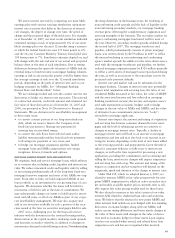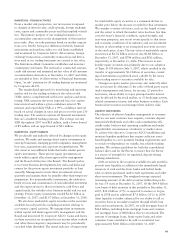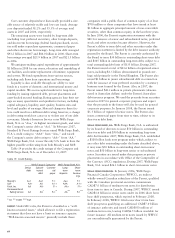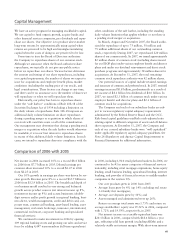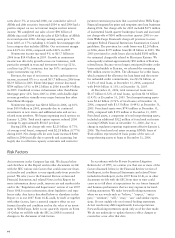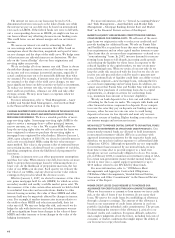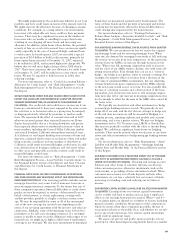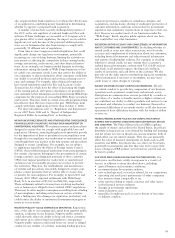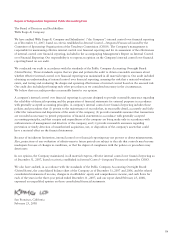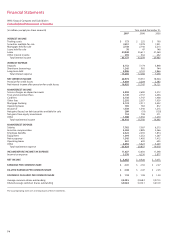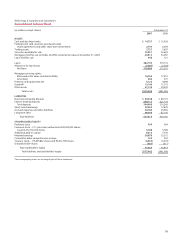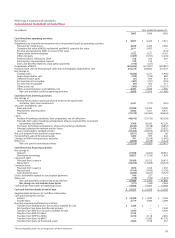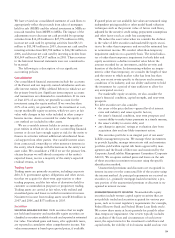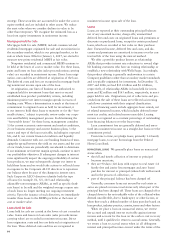Wells Fargo 2007 Annual Report Download - page 73
Download and view the complete annual report
Please find page 73 of the 2007 Wells Fargo annual report below. You can navigate through the pages in the report by either clicking on the pages listed below, or by using the keyword search tool below to find specific information within the annual report.70
of factors, including the then current market value of each
investment compared to its carrying value. Our venture capital
investments tend to be in technology and other volatile industries
globally, so the value of our public and private equity portfolios
can fluctuate widely. If we determine there is other-than-temporary
impairment for an investment, we will write-down the carrying
value of the investment, resulting in a charge to earnings. The
amount of this charge could be significant, especially if under
accounting rules we were required previously to write-up the
value because of higher market prices.
For more information, refer to “Risk Management – Asset/
Liability and Market Risk Management – Market Risk – Equity
Markets” in the Financial Review section of this Report.
WE RELY ON DIVIDENDS FROM OUR SUBSIDIARIES FOR REVENUE, AND
FEDERAL AND STATE LAW CAN LIMIT THOSE DIVIDENDS. Wells Fargo
& Company, the parent holding company, is a separate and dis-
tinct legal entity from its subsidiaries. It receives a significant
portion of its revenue from dividends from its subsidiaries. We
use these dividends to pay dividends on our common and pre-
ferred stock and interest and principal on our debt. Federal and
state laws limit the amount of dividends that our bank and some
of our nonbank subsidiaries may pay to us. Also, our right to
participate in a distribution of assets upon a subsidiary’s liquida-
tion or reorganization is subject to the prior claims of the sub-
sidiary’s creditors.
For more information, refer to “Regulation and Supervision
– Dividend Restrictions” and “– Holding Company Structure”
in our 2007 Form 10-K and to Notes 3 (Cash, Loan and
Dividend Restrictions) and 26 (Regulatory and Agency Capital
Requirements) to Financial Statements in this Report.
CHANGES IN ACCOUNTING POLICIES OR ACCOUNTING STANDARDS, AND
CHANGES IN HOW ACCOUNTING STANDARDS ARE INTERPRETED OR
APPLIED, COULD MATERIALLY AFFECT HOW WE REPORT OUR FINANCIAL
RESULTS AND CONDITION. Our accounting policies are fundamen-
tal to determining and understanding our financial results and
condition. Some of these policies require use of estimates and
assumptions that may affect the value of our assets or liabilities
and financial results. Five of our accounting policies are critical
because they require management to make difficult, subjective
and complex judgments about matters that are inherently uncer-
tain and because it is likely that materially different amounts
would be reported under different conditions or using different
assumptions. For a description of these policies, refer to
“Critical Accounting Policies” in the Financial Review section
of this Report.
From time to time the FASB and the SEC change the finan-
cial accounting and reporting standards that govern the prepara-
tion of our external financial statements. In addition, accounting
standard setters and those who interpret the accounting stan-
dards (such as the FASB, SEC, banking regulators and our out-
side auditors) may change or even reverse their previous inter-
pretations or positions on how these standards should be
applied. Changes in financial accounting and reporting stan-
dards and changes in current interpretations may be beyond
our control, can be hard to predict and could materially impact
how we report our financial results and condition. We could be
required to apply a new or revised standard retroactively or
apply an existing standard differently, also retroactively, in each
case resulting in our potentially restating prior period financial
statements in material amounts.
ACQUISITIONS COULD REDUCE OUR STOCK PRICE UPON ANNOUNCEMENT
AND REDUCE OUR EARNINGS IF WE OVERPAY OR HAVE DIFFICULTY
INTEGRATING THEM. We regularly explore opportunities to acquire
companies in the financial services industry. We cannot predict
the frequency, size or timing of our acquisitions, and we typically
do not comment publicly on a possible acquisition until we have
signed a definitive agreement. When we do announce an
acquisition, our stock price may fall depending on the size of
the acquisition, the purchase price and the potential dilution to
existing stockholders. It is also possible that an acquisition could
dilute earnings per share.
We generally must receive federal regulatory approval before
we can acquire a bank or bank holding company. In deciding
whether to approve a proposed bank acquisition, federal bank
regulators will consider, among other factors, the effect of the
acquisition on competition, financial condition, and future
prospects including current and projected capital ratios and lev-
els, the competence, experience, and integrity of management
and record of compliance with laws and regulations, the conve-
nience and needs of the communities to be served, including
the acquiring institution’s record of compliance under the
Community Reinvestment Act, and the effectiveness of the
acquiring institution in combating money laundering. Also, we
cannot be certain when or if, or on what terms and conditions,
any required regulatory approvals will be granted. We might be
required to sell banks, branches and/or business units as a condi-
tion to receiving regulatory approval.
Difficulty in integrating an acquired company may cause us
not to realize expected revenue increases, cost savings, increases
in geographic or product presence, and other projected benefits
from the acquisition. The integration could result in higher than
expected deposit attrition (run-off), loss of key employees, dis-
ruption of our business or the business of the acquired company,
or otherwise harm our ability to retain customers and employees
or achieve the anticipated benefits of the acquisition. Time and
resources spent on integration may also impair our ability to
grow our existing businesses. Also, the negative effect of any
divestitures required by regulatory authorities in acquisitions or
business combinations may be greater than expected.
FEDERAL AND STATE REGULATIONS CAN RESTRICT OUR BUSINESS, AND
NON-COMPLIANCE COULD RESULT IN PENALTIES, LITIGATION AND DAMAGE
TO OUR REPUTATION. Our parent company, our subsidiary banks
and many of our nonbank subsidiaries are heavily regulated at
the federal and/or state levels. This regulation is to protect
depositors, federal deposit insurance funds, consumers and the
banking system as a whole, not our stockholders. Federal and
state regulations can significantly restrict our businesses, and we
could be fined or otherwise penalized if we are found to be out
of compliance.
The Sarbanes-Oxley Act of 2002 (Sarbanes-Oxley) limits the
types of non-audit services our outside auditors may provide to
us in order to preserve their independence from us. If our audi-
tors were found not to be “independent” of us under SEC rules,
we could be required to engage new auditors and file new finan-
cial statements and audit reports with the SEC. We could be out
of compliance with SEC rules until new financial statements and
audit reports were filed, limiting our ability to raise capital and
resulting in other adverse consequences.
Sarbanes-Oxley also requires our management to evaluate
the Company’s disclosure controls and procedures and its inter-
nal control over financial reporting and requires our auditors to
issue a report on our internal control over financial reporting.
We are required to disclose, in our annual report on Form 10-K
filed with the SEC, the existence of any “material weaknesses”
in our internal control. We cannot assure that we will not find
one or more material weaknesses as of the end of any given year,
nor can we predict the effect on our stock price of disclosure of
a material weakness.
The Patriot Act, which was enacted in the wake of the
September 2001 terrorist attacks, requires us to implement new
or revised policies and procedures relating to anti-money laun-
dering, compliance, suspicious activities, and currency transac-
tion reporting and due diligence on customers. The Patriot Act



